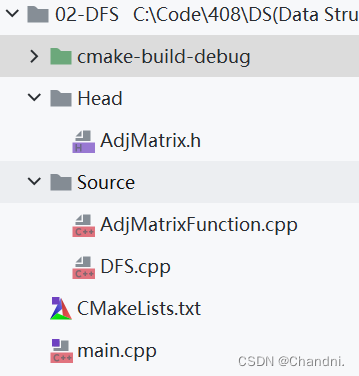目录
前言
此专栏包含408考研数据结构全部内容,除其中使用到C++引用外,全为C语言代码。使用C++引用主要是为了简化指针的使用,避免二重指针的出现。
已完成内容
[数据结构]:01-顺序表(C语言实现)_Chandni.的博客-CSDN博客
[数据结构]:02-单链表(C语言实现)_Chandni.的博客-CSDN博客
[数据结构]:03-栈(C语言实现)_Chandni.的博客-CSDN博客
[数据结构]:04-循环队列(数组)(C语言实现)_Chandni.的博客-CSDN博客
[数据结构]:05-循环队列(链表)(C语言实现)_Chandni.的博客-CSDN博客
[数据结构]:06-队列(链表带头结点)(C语言实现)_Chandni.的博客-CSDN博客
[数据结构]:07-二叉树(无头结点)(C语言实现)_Chandni.的博客-CSDN博客
[数据结构]:08-顺序查找(顺序表指针实现形式)(C语言实现)_Chandni.的博客-CSDN博客
[数据结构]:09-二分查找(顺序表指针实现形式)(C语言实现)_Chandni.的博客-CSDN博客
[数据结构]:10-二叉排序树(无头结点)(C语言实现)_Chandni.的博客-CSDN博客
[数据结构]:11-冒泡排序(顺序表指针实现形式)(C语言实现)_Chandni.的博客-CSDN博客
[数据结构]:12-快速排序(顺序表指针实现形式)(C语言实现)_Chandni.的博客-CSDN博客
[数据结构]:13-插入排序(顺序表指针实现形式)(C语言实现)_Chandni.的博客-CSDN博客
[数据结构]:14-选择排序(顺序表指针实现形式)(C语言实现)_Chandni.的博客-CSDN博客
[数据结构]:15-堆排序(顺序表指针实现形式)(C语言实现)_Chandni.的博客-CSDN博客
[数据结构]:16-归并排序(顺序表指针实现形式)(C语言实现)_Chandni.的博客-CSDN博客
[数据结构]:17-双链表(带头结点)(C语言实现)_Chandni.的博客-CSDN博客
[数据结构]:18-链栈(不带头结点)(C语言实现)_Chandni.的博客-CSDN博客
[数据结构]:19-串KMP模式匹配(数组)(C语言实现)_Chandni.的博客-CSDN博客
[数据结构]:20-线索二叉树(无头结点)(C语言实现)_Chandni.的博客-CSDN博客
[数据结构]:21-并查集(数组)(C语言实现)_Chandni.的博客-CSDN博客
[数据结构]:22-图(邻接矩阵)(C语言实现)_Chandni.的博客-CSDN博客
[数据结构]:23-图(邻接表)(C语言实现)_Chandni.的博客-CSDN博客
[数据结构]:24-图广度优先遍历(邻接矩阵)(C语言实现)_Chandni.的博客-CSDN博客
图深度优先遍历实现
01-开发环境
语言:C/C++14
编译器:MinGW64
集成开发环境:CLion2022.1.3
02-文件布局
请在CLion集成开发环境中创建C++可执行程序,否则无法运行,原因上面已解释。

03-代码
01-主函数
用于测试。
// 默认为无向图,若为有向图或网,请适当修改
#include "./Head/AdjMatrix.h"
#include "./Source/AdjMatrixFunction.cpp"
#include "./Source/DFS.cpp"
int main() {
// 初始化
AdjMGraph Graph;
InitGraph(Graph);
CreateGraph(Graph);
PrintGraph(Graph);
printf("VertexNum = %d,EdgeNum = %d\n", Graph.VexNum, Graph.EdgeNum);
printf("-----------------------------------\n");
// 深度优先遍历
// 0 1 4 5 2 6 3 7
// DFSTraverse(Graph);
// 删除0号结点插入8号结点
DeleteVertex(Graph, 0);
InsertVertex(Graph, 8);
AddEdge(Graph, 8, 2);
AddEdge(Graph, 4, 6);
// 深度优先遍历
// 8 2 3 6 4 5 1 7
DFSTraverse(Graph);
return 0;
}
02-头文件
用于存储结构体和常量等。
//
// Created by 24955 on 2023-04-02.
// 默认为无向图,若为有向图或网,请适当修改
//
#ifndef INC_01_ADJACENTMATRIX_ADJMATRIX_H
#define INC_01_ADJACENTMATRIX_ADJMATRIX_H
// 头文件
#include <stdio.h>
#include <stdlib.h>
// 常量
#define MAXSIZE 8
typedef int VertexType;
typedef int EdgeType;
// 结构体-邻接矩阵
typedef struct {
VertexType Vex[MAXSIZE];
// 可采用压缩存储
EdgeType Edge[MAXSIZE][MAXSIZE];
int VexNum, EdgeNum;
} AdjMGraph;
#endif //INC_01_ADJACENTMATRIX_ADJMATRIX_H
03-AdjMatrixFunction.cpp
用于存储邻接矩阵的基本操作。
//
// Created by 24955 on 2023-04-02.
// 默认为无向图,若为有向图或网,请适当修改
//
// 初始化图
void InitGraph(AdjMGraph &Graph) {
// 初始化顶点
for (int i = 0; i < MAXSIZE; i++) {
Graph.Vex[i] = -1;
}
// 初始化边
for (int i = 0; i < MAXSIZE; i++) {
for (int j = 0; j < MAXSIZE; j++) {
Graph.Edge[i][j] = 0;
}
}
Graph.VexNum = 0;
Graph.EdgeNum = 0;
}
// 输出邻接矩阵
void PrintGraph(AdjMGraph Graph) {
for (int i = 0; i < MAXSIZE; i++) {
printf("%2d\t", Graph.Vex[i]);
for (int j = 0; j < MAXSIZE; j++) {
printf("%2d", Graph.Edge[i][j]);
}
printf("\n");
}
}
// 获取元素下标
int GetIndex(AdjMGraph Graph, VertexType x) {
/*
* 1. 获取元素真实下标*/
int xIndex = -1;
for (int i = 0; i < MAXSIZE; i++) {
if (Graph.Vex[i] == x) {
xIndex = i;
break;
}
}
return xIndex;
}
// 插入顶点x
void InsertVertex(AdjMGraph &Graph, VertexType x) {
/*
* 1. 插入,顶点个数+1*/
if (Graph.VexNum == MAXSIZE) {
return;
}
for (int i = 0; i < MAXSIZE; i++) {
if (Graph.Vex[i] == -1) {
Graph.Vex[i] = x;
break;
}
}
Graph.VexNum++;
}
// 删除顶点x
void DeleteVertex(AdjMGraph &Graph, VertexType x) {
/*
* 1. 清除顶点,并修改顶点个数
* 2. 清除边,并修改边个数*/
// 清除顶点,将其值设为-1表示该顶点为空
int xIndex = GetIndex(Graph, x);
if (xIndex == -1) {
return;
}
Graph.Vex[xIndex] = -1;
Graph.VexNum--;
// 清除边
for (int i = 0; i < MAXSIZE; i++) {
if (Graph.Edge[xIndex][i]) {
Graph.EdgeNum--;
Graph.Edge[xIndex][i] = 0;
Graph.Edge[i][xIndex] = 0;
}
}
}
// 添加边
void AddEdge(AdjMGraph &Graph, VertexType x, VertexType y) {
/*
* 1. 获取顶点值实际下标
* 2. 插入边*/
int xIndex = GetIndex(Graph, x);
int yIndex = GetIndex(Graph, y);
if (xIndex == -1 || yIndex == -1) {
return;
}
// 添加边
Graph.Edge[xIndex][yIndex] = 1;
Graph.Edge[yIndex][xIndex] = 1;
Graph.EdgeNum++;
}
// 删除边
void RemoveEdge(AdjMGraph &Graph, VertexType x, VertexType y) {
/*
* 1. 获取顶点值实际下标
* 2. 删除边*/
int xIndex = GetIndex(Graph, x);
int yIndex = GetIndex(Graph, y);
if (xIndex == -1 || yIndex == -1) {
return;
}
// 删除边
Graph.Edge[xIndex][yIndex] = 0;
Graph.Edge[yIndex][xIndex] = 0;
Graph.EdgeNum--;
}
// 寻找图中顶点x的第一个邻接点
int FirstNeighbor(AdjMGraph Graph, VertexType x) {
/*
* 1. 寻找第一个不为0的值,并返回顶点值*/
int xIndex = GetIndex(Graph, x);
if (xIndex == -1) {
return -1;
}
for (int i = 0; i < MAXSIZE; i++) {
if (Graph.Edge[xIndex][i]) {
return Graph.Vex[i];
}
}
return -1;
}
// 图的下一个邻接点-除y以外的下一个邻接点顶点号
int NextNeighbor(AdjMGraph Graph, VertexType x, VertexType y) {
/*
* 1. 寻找y之后第一个不为0的值,并返回顶点值*/
int xIndex = GetIndex(Graph, x);
int yIndex = GetIndex(Graph, y);
if (xIndex == -1 || yIndex == -1) {
return -1;
}
// 寻找y之后的下一个邻接点
for (int i = yIndex + 1; i < MAXSIZE; i++) {
if (Graph.Edge[xIndex][i]) {
return Graph.Vex[i];
}
}
return -1;
}
// 创建图 - 主要方便测试,并非图的正确创建方式,应根据具体情况具体分析
void CreateGraph(AdjMGraph &Graph) {
Graph.VexNum = 8;
for (int i = 0; i < Graph.VexNum; i++) {
Graph.Vex[i] = i;
}
// 无向图
AddEdge(Graph, 0, 1);
AddEdge(Graph, 0, 4);
AddEdge(Graph, 1, 5);
AddEdge(Graph, 2, 5);
AddEdge(Graph, 2, 3);
AddEdge(Graph, 2, 6);
AddEdge(Graph, 5, 6);
AddEdge(Graph, 3, 6);
AddEdge(Graph, 3, 7);
AddEdge(Graph, 6, 7);
Graph.EdgeNum = 10;
}04-DFS.cpp
用于存储DFS函数。
//
// Created by 24955 on 2023-04-06.
// 默认为无向图,若为有向图或网,请适当修改
//
// 访问函数
void visit(AdjMGraph Graph, int x) {
printf("%3d", Graph.Vex[x]);
}
// 连通图深度优先遍历
void DFS(AdjMGraph Graph, int x, bool *visited) {
/*
* 1. 类似树的前序遍历*/
int xIndex = GetIndex(Graph, x);
visit(Graph, xIndex);
visited[xIndex] = true;
for (int w = FirstNeighbor(Graph, x); w != -1; w = NextNeighbor(Graph, x, w)) {
int wIndex = GetIndex(Graph, w);
// 若当前结点未被访问,访问并入队
if (!visited[wIndex]) {
DFS(Graph, w, visited);
}
}
}
// 深度优先遍历
void DFSTraverse(AdjMGraph Graph) {
/*
* 1. 设置结点是否已访问
* 2. 访问多个连通子图*/
bool visited[MAXSIZE];
for (int i = 0; i < MAXSIZE; i++) {
visited[i] = false;
}
for (int i = 0; i < MAXSIZE; i++) {
// 数组所存结点值和数组下标未必对应
if (!visited[i] && Graph.Vex[i] != -1) {
DFS(Graph, Graph.Vex[i], visited);
}
}
}结语
此博客主要用于408考研数据结构C语言实现记录,内有不足,可留言,可讨论。























 6331
6331











 被折叠的 条评论
为什么被折叠?
被折叠的 条评论
为什么被折叠?










